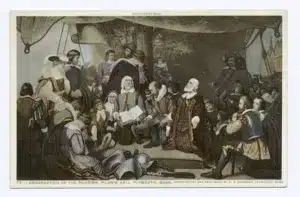In the early 17th century, a group of Pilgrims embarked on a perilous journey across the Atlantic Ocean in search of religious freedom. Their arrival on the shores of what would become the United States marked the beginning of a new chapter in history. As we gather to celebrate Thanksgiving, it’s worth delving into the details of the Pilgrims’ living conditions, particularly the type of flooring that lined their humble abodes.
The Pilgrims’ Living Conditions:
Picture the landscape of early Plymouth Colony – a cluster of simple structures dotting the rugged terrain. The Pilgrims’ houses were basic, constructed with practicality in mind rather than extravagance. The interiors reflected a stark simplicity, with limited furnishings and a focus on functionality.
 Flooring Materials of the Time:
Flooring Materials of the Time:
The materials available to the Pilgrims floors in their homes were derived from the bounties of the New England environment. Wood, straw, and clay were among the locally sourced materials that played a crucial role in shaping the Pilgrims’ living spaces.
Wooden flooring likely graced the interiors of Pilgrim homes. Native hardwoods, such as oak and pine, were readily available and provided a durable foundation for daily life. The creaking of wooden boards would have been a familiar sound as Pilgrims navigated their living spaces.
Yet, not all Pilgrim homes boasted wooden floors. In some instances, the practicalities of the environment led to the use of earthen or dirt floors. While less refined, these floors served as a testament to the Pilgrims’ adaptability, working in harmony with the land they called home.
Maintenance and Decoration:
Maintaining cleanliness in Pilgrim homes presented its own set of challenges. With limited tools and methods at their disposal, Pilgrims likely relied on basic sweeping and cleaning practices to keep their living spaces tidy.
To add a touch of comfort, Pilgrims floors may have employed simple coverings. Straw mats or animal hides could have adorned the wooden or earthen floors, providing a modicum of insulation and decoration. These coverings not only served practical purposes but also carried cultural significance.
Challenges and Considerations:
The New England climate, with its harsh winters and temperamental weather, played a crucial role in shaping the Pilgrims’ choices in flooring. Wooden floors, while durable, required special care to withstand the elements. Earthen floors, on the other hand, posed challenges during wet weather but were a practical choice in terms of insulation.
The Pilgrims’ flooring choices were not born out of luxury but rather out of necessity. Adapting to the circumstances of their new home, they prioritized functionality over opulence, crafting living spaces that mirrored their values and resilience.
Evolution of Flooring in Early America:
In the years following the Pilgrims’ arrival, flooring choices in early America underwent a transformation. As settlements expanded and trade routes opened, new materials and styles entered the scene. Hardwood floors became more prevalent, reflecting the changing times and tastes of the growing communities.
Conclusion:
As we gather to give thanks, it’s essential to reflect on the humble beginnings of our nation. The Pilgrims, with their simple yet resilient flooring choices, left an indelible mark on the history of early America. Their homes were not grand, but they were the foundations upon which a new society was built – a society that continues to evolve and grow with each passing generation. In the creaking of wooden boards and the whispers of history, we find a connection to the Pilgrims and the enduring spirit of Thanksgiving.
Read next: The History of Provenza Flooring



